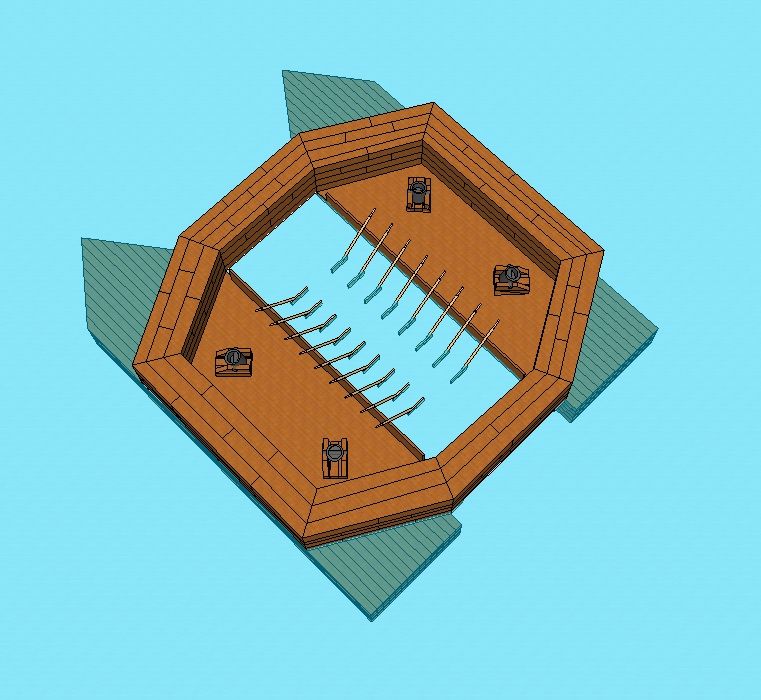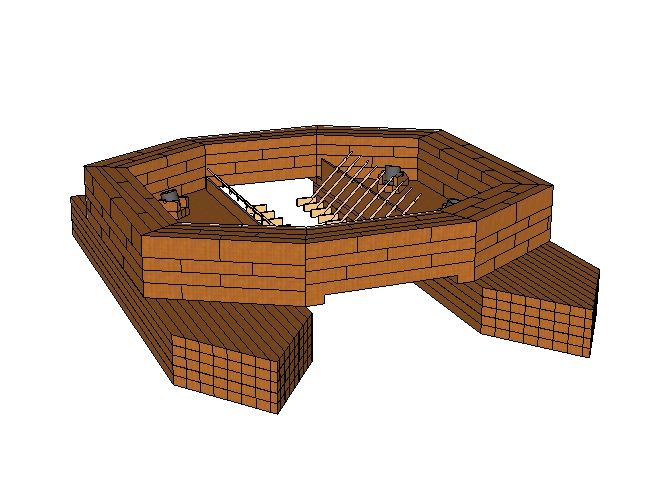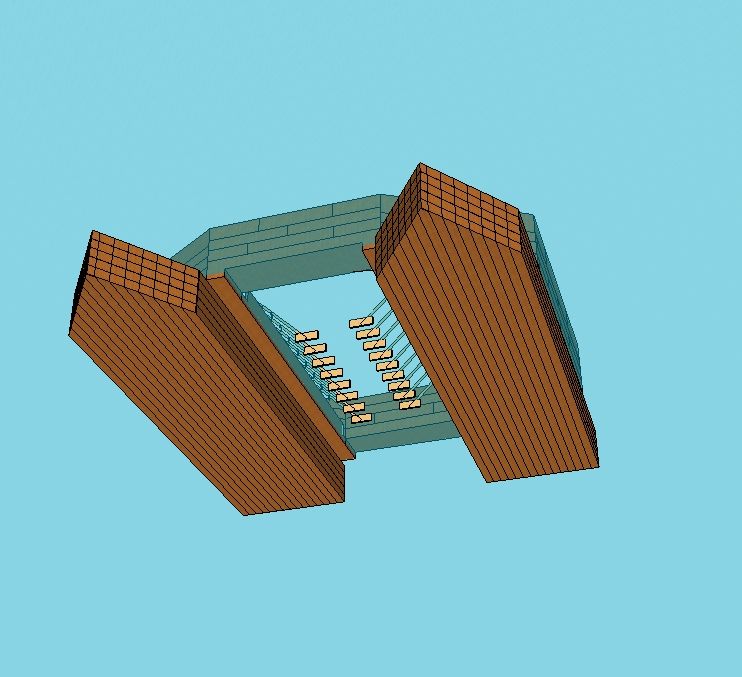Wars always inspire people to come up with innovative ways that might possibly bring a quick end to the conflict. One such person, during the war of 1812, was William Cooper, brother of James Fenimore Cooper, who had been a midshipman in the U.S. Navy contingent sent to Oswego, to build the brig Oneida in 1808.
William's plan was to build a floating battery, which could annihilate the British naval forces then existing on Lake Ontario. He offered to build such a vessel at his own expense, provided that the U.S. government furnished the arms and ammunition. (1)

William appears to have spent the winter of 1812-1813 in Oswego, drawing up plans for his floating battery. Although he’d lived on the frontier much of his life, he was aware of the advances made in warfare and the value of floating batteries. (2)
Hamilton Colton, who had resided in Oswego at this time, said that after Cooper’s plans were approved, the U.S. Navy agreed to pay him $16,000 for the battery, when it was delivered to Sackets Harbor. The Navy's policy was not to pay in advance of completion for such civilian enterprises. No record exists of any agreement. Cooper hired carpenters and set resolutely to work building what he called a floating battery. He ignored the ridicule of local residents, who dubbed his vessel "Cooper's Ark." The battery was constructed on a gravelly, semi-circular spit of land that jutted out into the lake, on the east side of the Oswego River. This was called Garrison Point because of its proximity to Fort Ontario.
Cooper was remembered locally as "an eccentric genius", who "acquired fame in advance of his battle - but fame of an unenviable character." It's apparent he considered this project his patriotic duty. He was only able to invest $2,500, or half of his original estimate in this floating wooden structure. He seems to have based this on his own plans. (3)
Sheldon C. Townsend recalled: "William Cooper entertained the belief that he was destined to immortalize his name as the builder of a vessel in Oswego harbor, which, armed, would prove largely instrumental in ending the conflict." The "ark" was to be armed with four brass mortar cannons of small caliber. Evidence of the military interest in this vessel is contained in a letter from Morgan Lewis, the military commander at Sackets Harbor, to John Armstrong, Secretary of War, which said it was designed "on a principle which was well thought of by most of our naval gentlemen." (4)
Studying Cooper's proposal leads to speculation on how he expected to maneuver such an unwieldy and armed vessel 45 nautical miles from Oswego to Sackets Harbor, minus a sail or rudder. Although the ark was to be equipped with sweeps, it wasn't exactly a Roman galley with slaves rowing to the cadence of a beating drum. Neither was it of the traditional design of a fighting ship. Although they do not appear in the design, some recalled that the "ark" indeed had a sail and a rudder, and was being sailed unarmed, except for two guns, to Sackets Harbor.



In his proposal to John Armstrong, Secretary of War, dated Feb. 17, 1813, William Cooper explained what he planned to build. He said the vessel would be supported by "two flat bottomed vessels 60 feet long by 15 feet wide, and 20 feet apart." He said the exterior and interior of the bulwark would be five feet thick, composed of oak. His calculations were based on the assumption that 49 cubic feet of dry oak weighed a ton, and that oak is 11/12 the weight of water; that five feet would be sufficient depth for the boats, to enable them to support the weight of the water. He said "The parts of the boats within the bulwarks are to be raised enough to give the whole sufficient buoyancy. Allowing the bulwark to be 7 feet high, viz: one foot under water, and six above, boats of the given dimensions will sustain, in addition, about 60 tons sufficient for everything.”
He went on to say: "Here then, we have a floating battery which cannot be sunk by an enemy, because the buoyant power is out of reach of shot. The crew are secure because no shot can penetrate the bulwark: the battery may be moved with ease in any direction, without the enemy being able to prevent it, because the power is out of reach of them. The battery may discharge shells of any size so near the enemy as to hit between wind and water, or, if they should not do that, they must still burst within their vessel, scattering fire and death. The battery may be made to turn rapid, so as to present, in quick succession, all the mortars to the same object, by rowing forward on one side and backing water (as termed) on the other. The battery may lay on an enemy's quarter, out of reach of many guns, if such a thing were important, without the enemy being able to change position quick enough to alter its elevated position.”
"Between the boats, and under the bulwark which is in these parts, near the surface of the water, the water has a free passage, so that the oars can be used with as much effect as if they were on the outside. An 18- pound shot was found by experiment at Woolwich (5), to penetrate 33 inches into dry oak. I have supposed that five feet would stop a 32- pound ball. But this can easily be ascertained.”
"Several oblong loop- holes may be left to discharge musquetry (cq) through if necessary; their height not to be two and a half feet above the water, so that even the lower guns of a man of war cannot strike them direct. Some circular holes descending from the inside, may also be left for the purpose of hanging hand-grenades on hooks at their mouths, and lighting their fuses, if boats should attempt to approach. A rudder may also be fixed on the inside. On each (of four) mortar may be sliding ropes of any length, to enable one to take aim with precision.
"It is not certain that a battery of this kind could destroy a ship of the line; either sinking her in a few discharges, by the large holes she could make between wind and water, or setting her on fire by the explosion of the bombs? I confess I should be willing to try the experiment.”
"The bulwark would contain less than 5,000 cubic feet of timber. The value I do not know; but if I allowed 50 cents a foot, it is only $2,500. The boats being flat bottomed cannot cost, I presume, $5,000. My former estimate, in all probability, was sufficiently liberal. If these suppositions are true - if, for less than $12,000 a battery can be constructed capable of destroying ships of the line, and moving on the same element, what city need to fear an attack? What nation an invasion? The history of the Art of War proves that almost every improvement has been so tardily or reluctantly adopted that the name of the inventor is lost. Few are disposed to introduce innovations, and those few seldom in power.”
"There is no necessity for confining the bombs to the common size. Why not discharge bombs two feet in diameter? The granite rock which struck one of Duckworth's squadron, weighed 800 pounds - As I before mentioned, it was acknowledged that, if it had struck between wind and water, the vessel must have sunk. Four large bombs would break in a surface as large as that rock - besides the mischief which the explosion could produce."
In a note to Armstrong on March 18, 1813 (6), Cooper wrote that he was in Oswego "with as many workmen as I can advantageously employ." On April 10, 1813, he wrote that his battery was "far advanced" and should be ready to sail by the first of May, should the mortars arrive. It appears only two guns arrived in time for the launching, such as it was. The crew was to consist of volunteers.

About mid-July, the floating fortress was as ready as it ever would be to sail for Sackets Harbor. Captain Zenas Gould, an experienced navigator, was put in charge and off they sailed. Aboard besides Gould were Cooper, 15 men to man the sweeps, and two or three prisoners. But when a sudden squall came up, as frequently occurs on Lake Ontario, it became completely unmanageable and went to pieces off New Haven, some eight or ten miles down the lake.
The wreck couldn't have occurred in a worse location - Mexico Bay. There lie the bones of many lost ships blown off course. Of catamaran design, the battery's structure connecting the twin hulls had to be sufficiently strong to allow them to move together in the seas rather than flex independently. They were two separate "flat bottomed vessels" or "boats" tied together by fastenings of some type to the bulwarks. But the bulwarks, as designed, do not appear to have been strong enough to withstand heavy waves and pounding. Even in light seas, the wave action would put much stress on the structure. (7)
Cooper wrote: "Impatient to get to the Harbour, I set sail before the decks were caulked or, indeed, entirely laid. Of course I was not prepared to encounter a heavy gale, which arose as I had every prospect of weathering Stony Point. Having but a dozen soldiers on board, all of whom were seasick, it was impossible to pump out the water as fast as it washed over the bulwarks, and run into the hold. She filled in about an hour and settled on the bottom, where, in the course of an hour and a half, she went to pieces." (8)
The Buffalo Gazette of Aug. 24, 1813, reported 15 men were navigating the ark, two of whom were drowned, and "the remainder considerably injured. He was calculated to carry 16 heavy guns, two only were mounted, and were both lost; we have heard since they are found, and gotten out of the water." Cooper lost a finger and received some light injuries.
What Cooper's effort clearly illustrated was a lack of wisdom in navigating his newly constructed battery over the often tempestuous open waters of Lake Ontario. Even during the summer months, dangerous squalls can develop quite suddenly.
The government, however, seems to have been impressed enough with Cooper's plans to give him the go-ahead, even though the conceptually flawed design did not make it appear that such a vessel would be very seaworthy - especially in rough weather. One may ask why Cooper's vessel was built at Oswego instead of Sackets Harbor. Historian Gary Gibson offers this:
"Shipbuilding facilities at Sackets Harbor were far superior as he must have known and then there would have been no need to sail the "ark" anywhere. I suspect the reason is the reception he would have received. Both Chauncey and Eckford would have found so many ways to criticize Cooper's design that even the army would not have been impressed. The navy, I'm confident, would have taken one look at the design and said 'no way!' At Oswego, he avoided that problem. He was apparently the subject of ridicule at Oswego - which bothered him. But he would have been subjected to much more of that at Sackets Harbor.”
Cooper wrote, "I have no doubt but it would have answered its intention if it had arrived safely in Sackets Harbor, or if I had even completed it before I left Oswego." (9)
Failure of the ark did not deter Cooper's spirit of patriotism. In his letter to Jefferson he wrote: "At a time when our enemy has announced his intention to prosecute the war with the utmost vigor against our towns, villages, and citizens, it becomes the duty of every American to aid his Government in repelling them. I shall not be deterred by one disaster from respectfully submitting a plan which I shall, I trust, demonstrate would completely banish them from our waters."
In this same letter to Jefferson, Cooper, who didn't let his "Ark" fiasco deter him, proposed a steam-driven ironclad floating fortress with "bulwarks, from two feet below the water line, of oak two feet thick, and enclose it completely with three inches of wrought iron." He enclosed a drawing of the vessel that resembles a Civil War period Confederate ironclad but with a centerline paddlewheel. It was much like Fulton's later steam frigate. Of course, the hydrodynamic efficiency of that scheme would be little better than his Ark's sweeps - as Fulton himself later discovered.
No response from Jefferson has been found. William Cooper eventually lost confidence in himself and returned home to Cooperstown. His failing fortunes and poor health soon turned him into a broken man. He wrote: "I am not, and probably, never shall be in any business by which money can be made or lost, and therefore must rest my security upon my patrimony." He died on Oct. 19, 1819, at the age of 34. Cooperstown Historian Alan Taylor observed: "Instead of becoming a great man, William Cooper Jr. ended up as a nothing. He was ruined by the insidious combination of too much money too easily had with expectations far beyond his abilities to achieve." (9)
Conclusion
Cooper's letter of November 24, 1813, to Thomas Jefferson, offers important firsthand evidence, in his own words, which provides insight into his intelligence, knowledge, state of mind, lessons learned, and facts pertaining to the loss of his floating battery. In that letter, he proposed a differently designed floating battery or batteries, and the enclosed plan or drawing demonstrated not only what Cooper had learned, but also that he still was thinking ahead in regard to the application of that form of technology to naval warfare.
While William Cooper may have been a visionary, he was far from "crazy" as some old time reminiscences suggests. Such an opinion seems to have been based on a lack of knowledge about innovations in naval warfare elsewhere. The progress of this nation has come as the result of innovative people, who were initially ridiculed for their forward thinking and then later lauded for their successes.
Ignoring ridicule, William put much time, effort, and money into his attempts to apply new technology to warfare. With a few design changes, his floating battery might have been a significant addition to the American fleet on Lake Ontario, during the War of 1812. He certainly deserves more acknowledgement and prominence than a brief mention in the local history books.
Footnotes
(1) Oswego Palladium, Feb. 2, 1877; letter from Cooper to Thomas Jefferson, Nov. 24, 1813, Thomas Jefferson Papers, Library of Congress, Series 1. By Cooper's own account after the fact, he said, "I did not think that I could, prudently, appropriate more than $2,500 for the object, and, therefore, constructed it but slightly."
(2), Taylor, Alan, "William Cooper's Town," Vintage Books 1996, P. 338; genealogical information provided by James Fenimore Cooper Society; Beard, James Franklin, The Letters and Journals of James Fenimore Cooper, Harvard University Press, Cambridge, Mass., 1960, Vol. 1, P. 27.
(3) Letter of William Cooper to John Armstrong, Secretary of War, dated Oswego, March 18, 1813. National Archives Record Group M221, Roll 51 Item C-87 (7); Johnson, Crisfield, History of Oswego County, L.H. Everts & Co., Philadelphia, Pa.1877, P. 63; Extract of a letter from Hamilton Colton, dated Milan, Ohio, Aug. 10, 1876 and published in the Oswego Weekly Palladium Aug. 16, 1876; letter, Cooper to Jefferson, op.cit.
(4) Otsego Herald, Cooperstown. N.Y., Aug. 21, 1913; Johnson, ibid; letter of Sheldon C. Townsend published in Oswego Palladium, Feb. 5, 1877; Letter of Morgan Lewis to John Armstrong, Secretary of War, Aug. 3, 1813, National Archives Record Group M221, Roll 51, Item C-87(7).
(5) Woolwich is home to the Royal Arsenal, a former arms manufacturing complex dating back to the 17th century, and the source of munitions and munitions testing for the Royal Navy and the British Army.
(6) Letter, Cooper to Armstrong, March 18, 1813, op. cit
(7) Townsend letter, op. cit.; Otsego Herald, op. cit.; the author has made an extensive study of shipwrecks that have occurred in Mexico Bay. Stony Point, where the "ark" was wrecked, can be very treacherous in a storm.
(8) Letter from Cooper to Jefferson, op. cit; letter, William Cooper to John Armstrong, Secretary of War, Feb. 7, 1813. National Archives Record Group M221, Roll 1 Item C-105 (7); Roll 54 Item L-140 (7) noted the vessel "was unfortunately lost in a violent gale of wind, with the loss of some of her men. The proprietor escaped with the loss of a finger."
(9) Taylor, op. cit. P. 338; Library of Congress file TJP-LC Series 1; death notice in Freeman's Journal and Otsego Herald, Cooperstown newspapers, October 15, 1819.
By Richard Palmer
Richard F. Palmer is a retired newspaper editor and reporter, and was well known for his weekly historical columns for the “Oswego Palladium-Times”, called "On the Waterfront." His first article for TI Life was written in January 2015 and since then, he has written a half-dozen others. He is a voracious researcher, and TI Life readers benefit from his interesting findings. Click here to see some of Richard Palmer’s TI Life Articles.
Posted in: Volume 15, Issue 7, July 2020, History, People, Poetry
Please click here if you are unable to post your comment.
